麦考瑞大学MKTG806课程描述
亲身体验!麦考瑞大学应用金融硕士
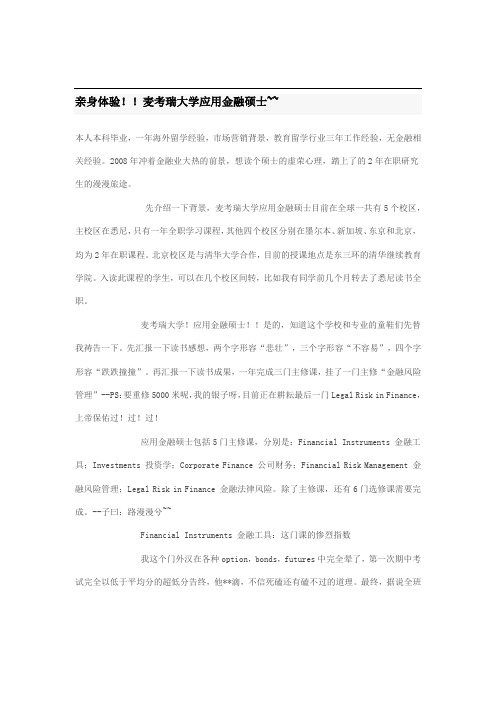
亲身体验!!麦考瑞大学应用金融硕士~~本人本科毕业,一年海外留学经验,市场营销背景,教育留学行业三年工作经验,无金融相关经验。
2008年冲着金融业大热的前景,想读个硕士的虚荣心理,踏上了的2年在职研究生的漫漫旅途。
先介绍一下背景,麦考瑞大学应用金融硕士目前在全球一共有5个校区,主校区在悉尼,只有一年全职学习课程,其他四个校区分别在墨尔本、新加坡、东京和北京,均为2年在职课程。
北京校区是与清华大学合作,目前的授课地点是东三环的清华继续教育学院。
入读此课程的学生,可以在几个校区间转,比如我有同学前几个月转去了悉尼读书全职。
麦考瑞大学!应用金融硕士!!是的,知道这个学校和专业的童鞋们先替我祷告一下。
先汇报一下读书感想,两个字形容“悲壮”,三个字形容“不容易”,四个字形容“跌跌撞撞”。
再汇报一下读书成果,一年完成三门主修课,挂了一门主修“金融风险管理”--PS:要重修5000米呢,我的银子呀,目前正在耕耘最后一门Legal Risk in Finance,上帝保佑过!过!过!应用金融硕士包括5门主修课,分别是:Financial Instruments 金融工具;Investments 投资学;Corporate Finance 公司财务;Financial Risk Management 金融风险管理;Legal Risk in Finance 金融法律风险。
除了主修课,还有6门选修课需要完成。
--子曰:路漫漫兮~~Financial Instruments 金融工具:这门课的惨烈指数我这个门外汉在各种option,bonds,futures中完全晕了,第一次期中考试完全以低于平均分的超低分告终,他**滴,不信死磕还有磕不过的道理。
最终,据说全班约1/3挂了,我PASS了。
我的宗旨是一路小P也忍了。
是不是没追求~~~不过这门课的老师超级认真,讲得也比较清楚,怀念中。
Investments 投资学:这门课的惨烈指数很热情的鬼佬,教学也比较灵活,有学生参与的过程,上课的内容也比较实用,各种计算。
麦考瑞大学和悉尼大学商科专业介绍
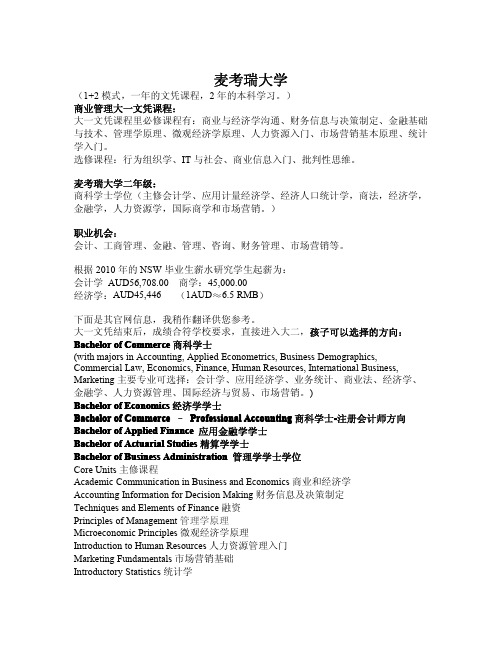
澳大利亚麦考瑞大学翻译硕士课程
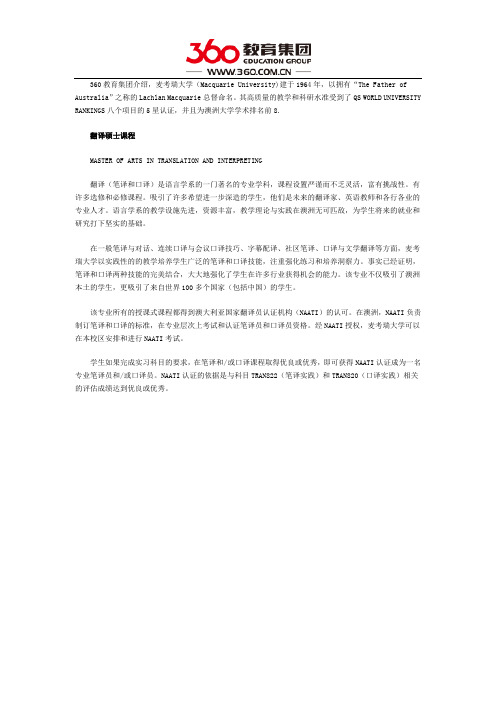
360教育集团介绍,麦考瑞大学(Macquarie University)建于1964年,以拥有“The Father of Australia”之称的Lachlan Macquarie总督命名。
其高质量的教学和科研水准受到了QS WORLD UNIVERSITY RANKINGS八个项目的5星认证,并且为澳洲大学学术排名前8.翻译硕士课程MASTER OF ARTS IN TRANSLATION AND INTERPRETING翻译(笔译和口译)是语言学系的一门著名的专业学科,课程设置严谨而不乏灵活,富有挑战性。
有许多选修和必修课程。
吸引了许多希望进一步深造的学生,他们是未来的翻译家、英语教师和各行各业的专业人才。
语言学系的教学设施先进,资源丰富,教学理论与实践在澳洲无可匹敌,为学生将来的就业和研究打下坚实的基础。
在一般笔译与对话、连续口译与会议口译技巧、字幕配译、社区笔译、口译与文学翻译等方面,麦考瑞大学以实践性的的教学培养学生广泛的笔译和口译技能,注重强化练习和培养洞察力。
事实已经证明,笔译和口译两种技能的完美结合,大大地强化了学生在许多行业获得机会的能力。
该专业不仅吸引了澳洲本土的学生,更吸引了来自世界100多个国家(包括中国)的学生。
该专业所有的授课式课程都得到澳大利亚国家翻译员认证机构(NAATI)的认可。
在澳洲,NAATI负责制订笔译和口译的标准,在专业层次上考试和认证笔译员和口译员资格。
经NAATI授权,麦考瑞大学可以在本校区安排和进行NAATI考试。
学生如果完成实习科目的要求,在笔译和/或口译课程取得优良或优秀,即可获得NAATI认证成为一名专业笔译员和/或口译员。
NAATI认证的依据是与科目TRAN822(笔译实践)和TRAN820(口译实践)相关的评估成绩达到优良或优秀。
澳洲留学择校 麦考瑞大学酒店管理工商管理学士课程信息简介
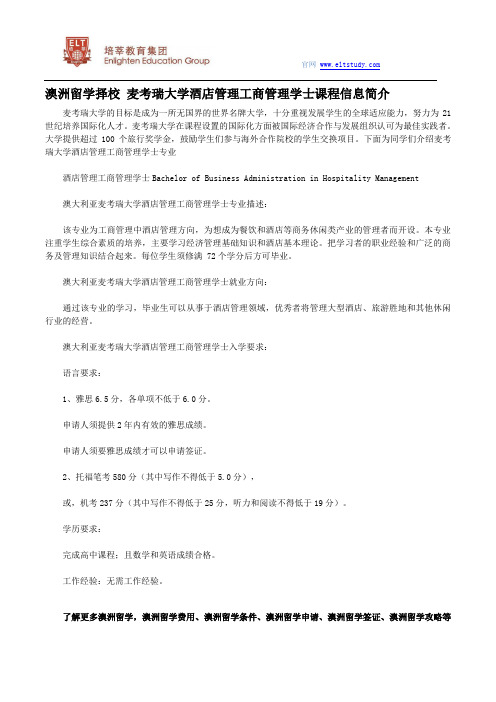
澳洲留学择校麦考瑞大学酒店管理工商管理学士课程信息简介麦考瑞大学的目标是成为一所无国界的世界名牌大学,十分重视发展学生的全球适应能力,努力为21世纪培养国际化人才。
麦考瑞大学在课程设置的国际化方面被国际经济合作与发展组织认可为最佳实践者。
大学提供超过100个旅行奖学金,鼓励学生们参与海外合作院校的学生交换项目。
下面为同学们介绍麦考瑞大学酒店管理工商管理学士专业酒店管理工商管理学士Bachelor of Business Administration in Hospitality Management澳大利亚麦考瑞大学酒店管理工商管理学士专业描述:该专业为工商管理中酒店管理方向,为想成为餐饮和酒店等商务休闲类产业的管理者而开设。
本专业注重学生综合素质的培养,主要学习经济管理基础知识和酒店基本理论。
把学习者的职业经验和广泛的商务及管理知识结合起来。
每位学生须修满 72个学分后方可毕业。
澳大利亚麦考瑞大学酒店管理工商管理学士就业方向:通过该专业的学习,毕业生可以从事于酒店管理领域,优秀者将管理大型酒店、旅游胜地和其他休闲行业的经营。
澳大利亚麦考瑞大学酒店管理工商管理学士入学要求:语言要求:1、雅思6.5分,各单项不低于6.0分。
申请人须提供2年内有效的雅思成绩。
申请人须要雅思成绩才可以申请签证。
2、托福笔考580分(其中写作不得低于5.0分),或,机考237分(其中写作不得低于25分,听力和阅读不得低于19分)。
学历要求:完成高中课程;且数学和英语成绩合格。
工作经验:无需工作经验。
了解更多澳洲留学,澳洲留学费用、澳洲留学条件、澳洲留学申请、澳洲留学签证、澳洲留学攻略等内容,可登陆培莘教育官网咨询。
2016麦考瑞大学翻译专业硕士
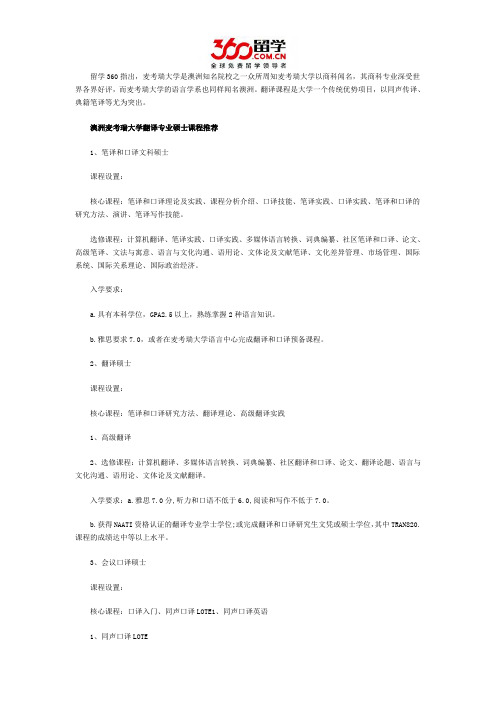
留学360指出,麦考瑞大学是澳洲知名院校之一众所周知麦考瑞大学以商科闻名,其商科专业深受世界各界好评,而麦考瑞大学的语言学系也同样闻名澳洲。
翻译课程是大学一个传统优势项目,以同声传译、典籍笔译等尤为突出。
澳洲麦考瑞大学翻译专业硕士课程推荐1、笔译和口译文科硕士课程设置:核心课程:笔译和口译理论及实践、课程分析介绍、口译技能、笔译实践、口译实践、笔译和口译的研究方法、演讲、笔译写作技能。
选修课程:计算机翻译、笔译实践、口译实践、多媒体语言转换、词典编纂、社区笔译和口译、论文、高级笔译、文法与寓意、语言与文化沟通、语用论、文体论及文献笔译、文化差异管理、市场管理、国际系统、国际关系理论、国际政治经济。
入学要求:a.具有本科学位,GPA2.5以上,熟练掌握2种语言知识。
b.雅思要求7.0,或者在麦考瑞大学语言中心完成翻译和口译预备课程。
2、翻译硕士课程设置:核心课程:笔译和口译研究方法、翻译理论、高级翻译实践1、高级翻译2、选修课程:计算机翻译、多媒体语言转换、词典编纂、社区翻译和口译、论文、翻译论题、语言与文化沟通、语用论、文体论及文献翻译。
入学要求:a.雅思7.0分,听力和口语不低于6.0,阅读和写作不低于7.0。
b.获得NAATI资格认证的翻译专业学士学位;或完成翻译和口译研究生文凭或硕士学位,其中TRAN820.课程的成绩达中等以上水平。
3、会议口译硕士课程设置:核心课程:口译入门、同声口译LOTE1、同声口译英语1、同声口译LOTE2、同声口译英语2、模仿会议1、模仿会议2、会议口译专业主题1、会议口译专业主题2、口译研究效果、高级连续口译1、高级连续口译2。
选修课程:论文、语言与文化沟通、语用论、国际系统、国际关系理论、国际政治经济、商业文化管理差异、市场管理。
入学要求:a.雅思7.0,听力和口语不低于6.0,阅读和写作不低于7.0。
b.具有NATTI的资格认证书;或完成翻译与口译文学硕士学位或研究生文凭,其中TRAN822.课程的平均成绩达中等以上。
澳洲麦考瑞大学商学硕士如何

除了在校的海外留学生以外,麦考瑞大学还有在日本、新加坡、香港及中国各地的分校学习大学课程的海外学生。
许多作为交换生的海外学生也选择在麦考瑞大学完成1至2个学期的课程。
麦考瑞大学在全球有超过250个合作院校,有多种不同的交换学习机会可供选择。
如,清华大学“应用金融硕士”项目是自2004年起与麦考瑞大学联合创办,由麦考瑞大学教师负责教学。
麦考瑞大学商学硕士专业基本信息:开设学位MS学费$33,600申请截止日期1月16日TOEFL要求83GPA要求75%可申请学期第一、二学期IELTS要求 6.5GRE要求Required工作经验要求Not Required 注:(1)商学硕士项目每年平均学费是AUD $33,600,每个课时学分是AUD $1,050。
(2)语言要求见申请说明。
申请说明立思辰留学360介绍,麦考瑞大学商学硕士项目(Master of Commerce):属于授课型硕士项目,学制2年,每年分两个学期开学,第一学期开学时间是2月份,第二学期开学时间是7月份。
具体申请要求见各个专业说明。
项目名称项目英文名GPA要求学位类型专业背景平均薪资会计Master of Commerce with a specialisation inAccounting2.7授课型会计、商学、其他$55,000精算研究Master of Commerce with a specialisation inActuarial Studies2.7授课型精算、统计学$56,175商业与组织管理Master of Commerce with a specialisation inBusiness Management and Organisations2.7授课型管理、其他$90,000企业管理Master of Commerce with a specialisation inCorporate Governance2.7授课型其他经济学Master of Commerce with a specialisation inEconomics2.7授课型其他$72,000金融Master of Commerce with a specialisation inFinance2.7授课型金融、经济、会计、数学、统计学金融犯罪与管理Master of Commerce with a specialisation inFinancial Crime and Governance2.7授课型其他人力资源管理Master of Commerce with a specialisation in HumanResource Management2.7授课型其他市场营销Master of Commerce with a specialisation inMarketing2.7授课型其他注:平均薪资数据来源于PayScale,此处的GPA要求主要对应的是美国GPA,换算成澳洲本科百分比是75%。
澳洲麦考瑞大学金融专业
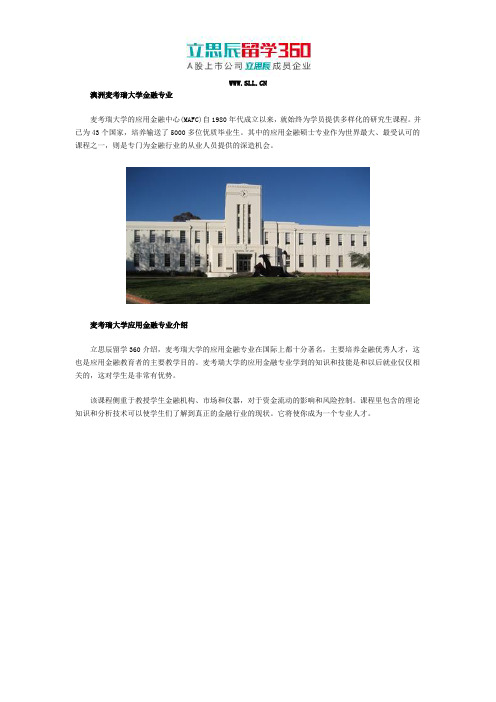
澳洲麦考瑞大学金融专业
麦考瑞大学的应用金融中心(MAFC)自1980年代成立以来,就始终为学员提供多样化的研究生课程。
并已为43个国家,培养输送了5000多位优质毕业生。
其中的应用金融硕士专业作为世界最大、最受认可的课程之一,则是专门为金融行业的从业人员提供的深造机会。
麦考瑞大学应用金融专业介绍
立思辰留学360介绍,麦考瑞大学的应用金融专业在国际上都十分著名,主要培养金融优秀人才,这也是应用金融教育者的主要教学目的。
麦考瑞大学的应用金融专业学到的知识和技能是和以后就业仅仅相关的,这对学生是非常有优势。
该课程侧重于教授学生金融机构、市场和仪器,对于资金流动的影响和风险控制。
课程里包含的理论知识和分析技术可以使学生们了解到真正的金融行业的现状。
它将使你成为一个专业人才。
麦考瑞大学应用金融专业入学要求
1.学术要求:
均分要求:均分4.5/7
背景专业要求:
1年:本科金融专业,至少两年金融工作经验;
1.5年:本科任何专业+至少两年金融工作经验
工作经验要求:
2.语言要求:
雅思:雅思:总分6.5,单项6
托福:总分 83,写作21,口语18,阅读13,听力12。
关于澳洲热门专业澳洲麦考瑞大学专业介绍的参考资料
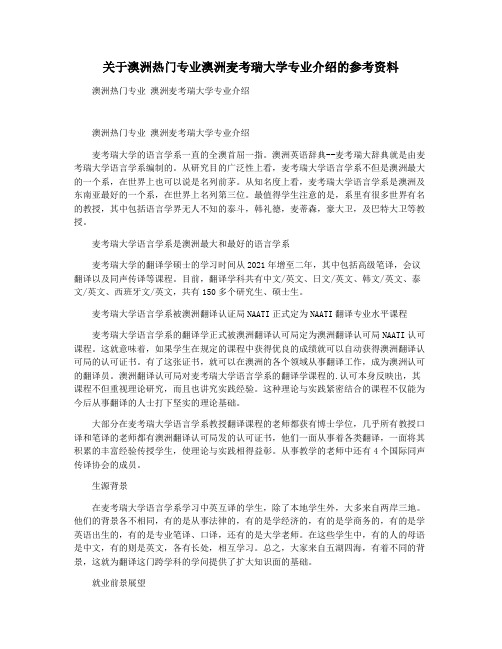
关于澳洲热门专业澳洲麦考瑞大学专业介绍的参考资料澳洲热门专业澳洲麦考瑞大学专业介绍澳洲热门专业澳洲麦考瑞大学专业介绍麦考瑞大学的语言学系一直的全澳首屈一指。
澳洲英语辞典--麦考瑞大辞典就是由麦考瑞大学语言学系编制的。
从研究目的广泛性上看,麦考瑞大学语言学系不但是澳洲最大的一个系,在世界上也可以说是名列前茅。
从知名度上看,麦考瑞大学语言学系是澳洲及东南亚最好的一个系,在世界上名列第三位。
最值得学生注意的是,系里有很多世界有名的教授,其中包括语言学界无人不知的泰斗,韩礼德,麦蒂森,豪大卫,及巴特大卫等教授。
麦考瑞大学语言学系是澳洲最大和最好的语言学系麦考瑞大学的翻译学硕士的学习时间从2021年增至二年,其中包括高级笔译,会议翻译以及同声传译等课程。
目前,翻译学科共有中文/英文、日文/英文、韩文/英文、泰文/英文、西班牙文/英文,共有150多个研究生、硕士生。
麦考瑞大学语言学系被澳洲翻译认证局NAATI正式定为NAATI翻译专业水平课程麦考瑞大学语言学系的翻译学正式被澳洲翻译认可局定为澳洲翻译认可局NAATI认可课程。
这就意味着,如果学生在规定的课程中获得优良的成绩就可以自动获得澳洲翻译认可局的认可证书。
有了这张证书,就可以在澳洲的各个领域从事翻译工作,成为澳洲认可的翻译员。
澳洲翻译认可局对麦考瑞大学语言学系的翻译学课程的.认可本身反映出,其课程不但重视理论研究,而且也讲究实践经验。
这种理论与实践紧密结合的课程不仅能为今后从事翻译的人士打下坚实的理论基础。
大部分在麦考瑞大学语言学系教授翻译课程的老师都获有博士学位,几乎所有教授口译和笔译的老师都有澳洲翻译认可局发的认可证书,他们一面从事着各类翻译,一面将其积累的丰富经验传授学生,使理论与实践相得益彰。
从事教学的老师中还有4个国际同声传译协会的成员。
生源背景在麦考瑞大学语言学系学习中英互译的学生,除了本地学生外,大多来自两岸三地。
他们的背景各不相同,有的是从事法律的,有的是学经济的,有的是学商务的,有的是学英语出生的,有的是专业笔译、口译,还有的是大学老师。
- 1、下载文档前请自行甄别文档内容的完整性,平台不提供额外的编辑、内容补充、找答案等附加服务。
- 2、"仅部分预览"的文档,不可在线预览部分如存在完整性等问题,可反馈申请退款(可完整预览的文档不适用该条件!)。
- 3、如文档侵犯您的权益,请联系客服反馈,我们会尽快为您处理(人工客服工作时间:9:00-18:30)。
MKTG806 Applied Marketing StrategySemester 2, 2012Room: C5C 209Monday 12 – 3 pm Department of Marketing and ManagementMACQUARIE UNIVERSITYFACULTY OF BUSINESS AND ECONOMICSUNIT GUIDEYear and Semester: S2, 2012Unit convenor: Professor Scott KoslowPrerequisites: MKTG696 or admission to MCom or MintBus or MEc orMActPrac prior to 2011Credit points: FourStudents in this unit should read this unit guide carefully at the start of semester. It contains important information about the unit. If anything in it is unclear, please consult one of the teaching staff in the unit.A BOUT THIS UNIT∙This is a capstone unit that takes students through the whole marketing strategy process, such as identifying options, evaluating and assessing competitivepositioning, and choosing how and where to compete, and assessing performance.Students have the opportunity to apply their knowledge to the commercialenvironment. Students will build upon their marketing knowledge gained in market research, consumer behaviour, marketing communications and marketingmanagement, and participate in case discussions to develop strategic initiatives for real world commercial businesses.∙The applied orientation of the unit is to help build a bridge between the theoretical knowledge they have gain in their course and the real world applications students will face once they graduate.T EACHING STAFF∙Lecturer: Lawrence Potter (lawrencep@.au; 0418 408 931)C ONTACTING STAFF∙Consultation times: BY ARRANGEMENT ONLY. Planned Consultations can be scheduled for a Monday (prior to midday) or Tuesday. Location at MQ to beconfirmed.∙You are encouraged to seek help in person during regular consultation hours. In special circumstances, an appointment may be made outside regular consultation hours. Staff will not conduct consultations by email.∙Students experiencing significant difficulties in the unit must seek assistance immediately.C LASSES∙Number and length of classes: 3 hours face-to-face teaching per week for 13 weeks, consisting of lectures and student presentations∙The timetable for classes can be found on the University web site at: .au/∙Students are expected to participate in lectures. Attendance will be taken in class. ∙Warning: You MUST attend a minimum 11 of the 13 classes. Failure to do so will lead to a major deduction in your overall marks.∙To avoid incurring a penalty, medical certificates must be provided if you are not able to attend a class. Work-related reasons are NOT accepted for your absence. ∙You are expected to arrive on time and not to leave until the class ends.∙If you have a recurring problem that makes you late, or forces you to leave early, have the courtesy to discuss this with your lecturer.∙Mobile phones must be turned off and not simply set to “silent”. Students whose phones make audible sounds (whether by tone or vibration), will owe an apology to the class for wasting their time. Part of that apology is to bring a nice snack for the next period. For example, Tim Tams or other “nice” bickies are acceptable,providing 1-2 cookies per student in the unit (plus the lecturer!). Tasty home baked snacks are preferred. Failure to provide an appropriate apology for your noisy electronics means you are not welcome in class.∙Laptops MAY NOT BE USED in the class unless specified.P RIZES∙NoneR EQUIRED AND R ECOMMENDED TEXTS AND/OR MATERIALS∙Required text: Aaker, David A. (2011), Strategic Market Management, John Wiley & Sons.∙Aaker text can be purchased from the Macquarie University Co-op Bookshop.∙Required cases: Eleven cases total, see weekly schedule for listing (ten cases are discussed during the term and one is used in the exam).∙Copyrights for use of cases have been purchased directly from Harvard Business School Publishing by the Faculty of Business and Economics. This is major coup for students in holding down their unit materials costs. Relevant Cases will be available via i-Learn on the Tuesday following class.T ECHNOLOGY U SED AND R EQUIRED∙Normal technology requirementsU NIT WEB PAGE∙Course material is available on the learning management system (iLearn)L EARNING OUTCOMESThe learning outcomes of this unit are:1. Learn how to analyse, synthesise and evaluate marketing strategies.2. Understand and analyse the complexities of the business environment andhow these influence marketing strategy.3. Understand how to use market segmentation concepts and generatepotential segmentation schemata.4. To understand and apply core marketing strategy concepts like competitiveadvantage, synergies, positioning and brandingG RADUATE C APABILITIESThis unit contributes to this by developing the following graduate capabilities:1. Discipline Specific Knowledge and Skills*2. Critical, Analytical and Integrative Thinking3. Creative and Innovative4. Capable of Professional and Personal Judgement and InitiativeL EARNING AND T EACHING A CTIVITIES∙This unit is taught through: lectures, case studies, readings, reflective activities and self-directed learning.∙Students will spend about half the classroom time listening to lectures and discussing the content. Students need to read the appropriate portions of thetextbook before coming to class.∙Students will spend the other half of classroom time on case discussion.Students are expected to have the cases read and analysed prior to class and be able to write out brief assessments of their views in class. Case discussions will include some small group discussions, but also discussion within the whole class.∙Where there is a case, the typical break down in time will be the first 90min to two hours of the class time spent on the case with the reminder on the lecture ∙When no case is discussed, all whole three-hour session will be lecture and discussion.R ESEARCH AND P RACTICE∙T his unit uses research from external sources (see Harvard Business School cases listed in the weekly schedule)∙T his unit gives you practice in applying research findings in your assignments R ELATIONSHIP BETWEEN A SSESSMENT AND L EARNING O UTCOMES∙Extension will not be granted.∙Late submissions will not be accepted. Weekly Schedule – Monday Class DatesASSESSMENT TASKSAssessment 1: Case Study - 6 in total over the Weeks 2-7 inclusive (30%)Marking is made up of participation and journal marks assessed as follows: ∙PARTICIPATION MARKSThe case participation method of assessment is composed of the lecturer‟sweekly assessment of your oral contributions to case discussions. Please note that a participation mark assesses the QUALITY of input not the QUANTITY!That is, oral case comments that provide fresh insights, give analysis andsynthesis of case material, and provoke further thought and discussion arerewarded highly, whereas comments that simply repeat case facts withoutgoing any further are not rewarded. Also, participants often misunderstand that their participation mark is based on their best contributions, not their averagecontribution. For example, after each case discussion, participants who make high quality comments are recorded as having …high‟ or …very high‟ levels ofperformance. Usually, not more than 25% of the class receives a …high‟ or …very high‟ mark in any particular week. However, it only takes a few …high‟ or …veryhigh‟ marks to gain a high overall mark for participation.∙JOURNAL MARKSAnother method of assessing your learning is the use of journals. At thebeginning of case discussions, record in your journal your personal analysis of that week‟s case. You should come to case discussions prepared to write ashort evaluation of the case issues. The first few minutes in class will beallowed for writing these thoughts in your journals. You are not allowed to refer to the case at this time, but you may refer to notes. At the end of class, you will write in your journal again, this time noting how your opinion of the case haschanged since your first entry. The focus of the second entry is on what kinds of learning have taken place during the case discussion. Then the journals are returned to the lecturer who will keep them until the next week. Participantjournals are marked on how well higher level thinking skills (analysis, synthesis and evaluation) and demonstrated in case discussions One third weighting ison the first half of the journal, and two thirds on the second half.∙COMBINING MARKSNote that journal marks are used as a check on participation and vice versa. If your journal mark is low enough that the lecturer questions whether you readthe case, your participation mark will fall. If your journal comments on what youlearned don‟t match what you said in case discussion, this will be taken intoaccount as well. For most students most of the time, journals and participation will have 50:50 weightings, not always will this be the case. Sometimesstudents will receive the lower of the two marks, but sometimes the higher ofthe two.Assessment 2: Group Project – Indigenous Program for Schools OR Tourism (30%)Working with Muru Mittigar (.au) groups are to develop a strategic marketing program for one of the two initiatives Schools Program or Tourism Program. The program will be assigned to the Groups in Week 1 of the Semester and will culminate in a Strategic Report and Presentation.A peer review will be conducted at the completion of this project, the result of which will help to determine individual scores for the group project. The peer review form is attached in Appendix I in the end of this unit outline.In developing the Marketing Plan you are to complete the following criteria below.∙Remember this is to be a real business and therefore you will need to assess exactly what is happening and develop strategies that are realistic andformulated on the current and previous performance.∙The group is to assume the role of Marketing Manager and demonstrate knowledge of the market/industry, identify relevant marketing theories anddevelop practical marketing strategies for the business, and clearlydemonstrate how those marketing theories apply.ESSENTIAL Aspects of the Marketing Report∙Product and Service Offering: what is the product offer and experience, USP‟s and key product benefits of the Muru Mittigar experience.∙IMC Program: what is the appropriate message and communication strategy for the business.∙Social Media Strategy: Evaluate the current strategy and develop a social media strategy and calendar for the ensuing 12 month period (Jan – Dec2013).∙Market Expansion Program: develop a domestic market strategy targeting key distribution channels (this may include hotels, tourism partners, schoolspartnerships and cultural entities depending on the assigned project),promotional opportunities (advertising, sponsorship etc.), and awarenessprogram.The Group Presentation will be to a Board Presentation and as such you will be evaluated on the whole groups‟ ability to present and answer questions in relation to your Marketing Plan. Each group will be allocated 30 minutes for their presentation time of which you will need to allow 10 minutes for questions in relation to the strategies presented.MARKETING REPORT STRUCTURE:As a guide (ONLY) the Plan could cover the following sections. You will need to work through which aspects are the most important to your plan and concentrate on those areas that are relevant:∙Executive Summary – a summary of your findings and recommendations.∙Current Situation and Market Overview – an assessment as to what is currently happening. An evaluation of the internal and external environmental factorsthat are likely to impact on the industry and on the products and services ofyour organisation.∙Positioning Statement – What does your business stand for what are the marketing initiatives that you will undertake to gain business. What services will you offer, what facilities are required, is space and issue? This will includeidentifying your key market target and defining how you want them to perceive your products or services relative to competition. State the core concept used to position the product (brand) in the eyes and mind of the targeted buyer. The positioning statement should describe: (1) What criteria or benefits thecustomer when buying a product along with the level of importance, (2) Whatwe offer that differentiates our product from competition, and (3) The limitations of competitive products.∙Marketing Mix Strategy for each market target.o Product strategy – Identify the key benefits the product offers to meet stakeholder/customer needs. Other issues that may be addressedwould be new product suggestions, adjustments in the mix of existingproducts, and new product options.o Price strategy – The overall pricing strategy (i.e. competitive, premium priced etc.) should be identified along with a cost/benefit analysis ifapplicable. Identify what role you want price to play. What is thebreakeven position based on the pricing strategy.o Distribution Strategy- Describe specific distribution strategies for each market target. Issues to be addressed are intensity of distribution(market coverage), how distribution will be accomplished either direct orvia a partner network. The role of the sales force, and external partiesmay also need to be considered.o Promotion Strategy – Promotion strategy is used to initiate and maintain a flow of communication between company and the target market. Toassist in developing the communications program, the attributes andbenefits of your product or service should be identified for each markettarget. How the product differs from competition (competitive advantage)should be listed. Strategies should be listed for personal selling,advertising, sales promotion, and public relations activities.Develop projected Customer acquisition targets and a marketing budget – Based on the size and potential growth of the market, estimate potential sales for the product, market share and the marketing expenditure required to achievemarketing objectives over a three year period.KEY MILESTONE DATES:Week 5 – Key Issues Report & IN CLASS Presentation (10 mins):Key findings from research and conclusions inrelation to strategy. Project aims, objectives andtimeline. Max 5 pages (5%).Week 11 – FINAL Report: submission of the FINAL Report. Report Details willbe delivered in class (Weeks 1 and 2) and theReport Framework available on i-Learn from Week 3. The FINAL Report is to display academic theory and commercial application to the task and demonstrated balance will be required using the appropriate business models. Max 15 pages 20%.Week 11/12 – Presentation: Groups will present the key findings andconclusions of the report. This will be a 20 minutePresentation and delivered in class. ALL STUDENTS are expected to attend these two weeks. MARKS will be deducted for non- attendance. Max 15 slides in TOTAL.PowerPoint Slides are to be printed and submitted for marking at the conclusion of the Presentation. Combined Mark is (5%)Assessment 3: FINAL Exam (40%)A final examination is included as an assessment task for this unit to provideassurance that:i) the product belongs to the student andii) the student has attained the knowledge and skills tested in the exam.A 3 hour final examination for this unit will be held during the UniversityExamination period.The University Examination period in Second Half Year 2012 is from Monday 12 November to Friday 30 November 2012.The exam will ask questions based on a Case Study. The relevant Case Study will be supplied in Week 9. Students are expected to be highly familiar with the case prior to the exam. However, students are not allowed to refer to a print out of the case, nor notes on the case, during the examination. Any relevant documentation for the Examination will be supplied as part of the Examination Paper.You are expected to present yourself for examination at the time and placedesignated in the University Examination Timetable. The timetable will beavailable in Draft form approximately eight weeks before the commencement of the examinations and in Final form approximately four weeks before thecommencement of the examinations.http:// .au/The only exception to not sitting an examination at the designated time is because of documented illness or unavoidable disruption. In these circumstances you may wish to consider applying for Special Consideration. The University‟s policy on special consideration process is available at.au/policy/docs/special_consideration/policy.htmlIf a Supplementary Examination is granted as a result of the Special Consideration process the examination will be scheduled after the conclusion of the officialexamination period. (Individual Faculties may wish to signal when the Faculties‟ Supplementary Exams are normally scheduled.)The Macquarie university examination policy details the principles and conduct of examinations at the University. The policy is available at:.au/policy/docs/examination/policy.htmA CADEMIC H ONESTYThe nature of scholarly endeavour, dependent as it is on the work of others, binds all members of the University community to abide by the principles of academic honesty. Its fundamental principle is that all staff and students act with integrity in the creation, development, application and use of ideas and information. This means that: ∙all academic work claimed as original is the work of the author making theclaim∙all academic collaborations are acknowledged∙academic work is not falsified in any way∙when the ideas of others are used, these ideas are acknowledged appropriately.Further information on the academic honesty can be found in the Macquarie University Academic Honesty Policy at.au/policy/docs/academic_honesty/policy.htmlGRADESMacquarie University uses the following grades in coursework units of study:HD - High DistinctionD - DistinctionCR - CreditP - PassF - FailGrade descriptors and other information concerning grading are contained in the Macquarie University Grading Policy which is available at:.au/policy/docs/grading/policy.htmlG RADING A PPEALS AND FINAL EXAMINATION SCRIPT VIEWINGIf, at the conclusion of the unit, you have performed below expectations, and are considering lodging an appeal of grade and/or viewing your final exam script please refer to the following website which provides information about these processes and the cut off dates in the first instance. Please read the instructions provided concerning what constitutes a valid grounds for appeal before appealing your grade..au/new_and_current_students/undergrad uate_current_students/how_do_i/grade_appealsS PECIAL C ONSIDERATIONThe University is committed to equity and fairness in all aspects of its learning and teaching. In stating this commitment, the University recognises that there may be circumstances where a student is prevented by unavoidable disruption from performing in accordance with their ability. A special consideration policy exists to support students who experience serious and unavoidable disruption such that they do not reach their usual demonstrated performance level. The policy is available at: .au/policy/docs/special_consideration/policy.htmlS TUDENT S UPPORT S ERVICESMacquarie University provides a range of Academic Support Services. Details of these and other services for students can be accessed at.au.The Faculty of Business and Economics also provides specific support in the form of BESS, Room, PAL, and E4B Consultation Room.IT C ONDITIONS OF U SEAccess to all student computing facilities within the Faculty of Business and Economics is restricted to authorised coursework for approved units. Student ID cards must be displayed in the locations provided at all times.Students are expected to act responsibly when using University IT facilities. The following regulations apply to the use of computing facilities and online services:∙Accessing inappropriate web sites or downloading inappropriate material is not permitted. Material that is not related to coursework for approved units is deemed inappropriate.∙Downloading copyright material without permission from the copyright owner is illegal, and strictly prohibited. Students detected undertaking such activities will face disciplinary action, which may result in criminal proceedings.Non-compliance with these conditions may result in disciplinary action without further notice.Students must use their Macquarie University email addresses to communicate with staff as it is University policy that the University issued email account is used for official University communication.Appendix IYour Name: ____________________________Your Group: ____________________________FBE version 13 6/1/12 1Other comments: (about your group, the subject, your topic, etc.)possible for different members of the same group to be awarded different marks due to the scores received in the individual assessment. Please also note that if a group member appeals, the contribution forms of other group members may be shown to justify marks. If you are going to award a group member a lower percentage contribution you may be required to supply evidence to justify your actions.THIS IS AN INDIVIDUAL contribution and is required to be submitted via email no later than the Friday after the presentation in Week 11 or 12 as allocated.FBE version 13 6/1/12 2。
